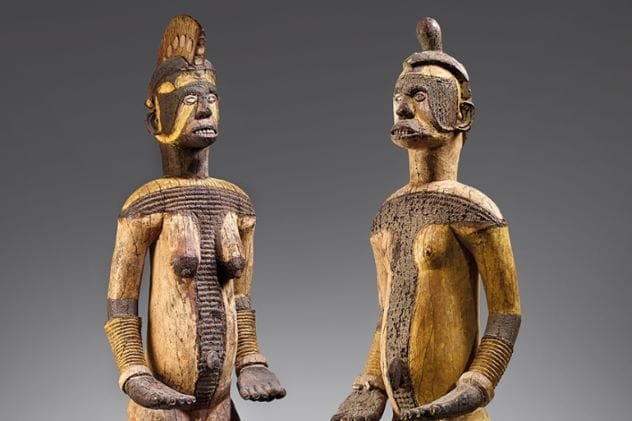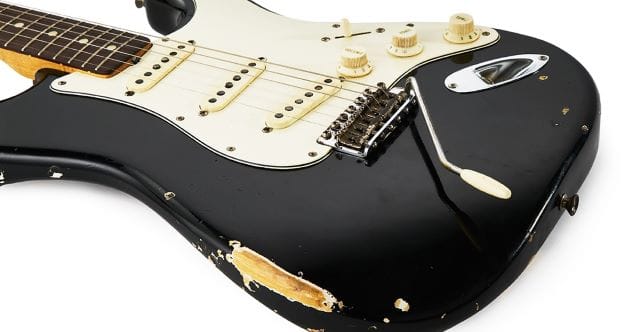When the gavel falls on fine art masterpieces or ancient relics at high-stakes auctions, one word is paramount: provenance. This refers to the documented history of an item’s ownership. Before shelling out millions, buyers understandably want solid proof that what they’re getting is authentic and legally owned by the seller. Auction houses usually demand thorough provenance documentation.
However, some auctions have proceeded, leaving a trail of eyebrow-raising sales and lingering questions about an item’s true story and history. Let’s delve into 10 such high-dollar auction items whose origins are, shall we say, a bit murky.
The Tutankhamen Head
In July 2019, Christie’s in London featured a stunning “Egyptian Brown Quartzite Head of the God Amen with the features of the Pharaoh Tutankhamen.” Dated to Tutankhamen’s reign (circa 1333-1323 BC), it fetched a staggering £4,746,250 (around $6.4 million USD). This impressive sale happened despite its history being unclear before the 1960s.
Adding to the drama, the Egyptian government contested the sale. They claimed the artifact was likely stolen from an Egyptian temple and illegally taken out of the country in the 1970s. The International Association of Dealers in Ancient Art (IADAA) countered that shipping Egyptian antiquities abroad was common until Egypt banned such sales in 1983. The head was sold to another private collector, its current location unknown, and the debate over its ownership and origin continues.
The Jimi Hendrix Monterey Stratocaster
Imagine playing Jimi Hendrix’s $10 million guitar! YouTuber Paul Davids thought he did in a December 2021 video, featuring a black Fender Stratocaster said to be the one Hendrix played at the 1967 Monterey Pop Festival. However, sharp-eyed Hendrix fans spotted inconsistencies. Marks on the guitar in Davids’s video didn’t quite match footage of Hendrix’s actual Strat.
A key difference was a missing chunk of black finish on the back of Hendrix’s guitar, which seemed to be in a different spot on the guitar in question. Doubts grew when it emerged that Heritage Auctions had planned to sell this guitar in 2017 but halted the sale after experts questioned its authenticity. Davids eventually removed his video. Despite this, Myles Poulton, who arranged for Davids to play it, still believes it’s the real deal, though many remain skeptical.
The Hitler Phone
In 2017, Alexander Historical Auctions in Maryland sold a grim artifact: a red phone supposedly used by Adolf Hitler in his World War II bunker. Considering the horrific orders likely issued from it, the auction house called it “arguably the most destructive ‘weapon’ of all time.” Someone paid $243,000 for it, but serious doubts about its provenance quickly surfaced.
Frank Gnegel from the Frankfurt Museum for Communication declared the phone a “clear fake.” Dutch telephone expert Arwin Schaddelee also listed his doubts, noting several British parts – unusual for 1940s Germany, especially since Britain was an enemy. He also pointed out that the cords were from a later period and that stories about the phone’s origins had changed over time. The auction house, however, stands by its authenticity, despite the shaky evidence.
Igbo Sacred Art

The Igbo people are a major ethnic group in Nigeria. In June 2020, a pair of their sacred art objects were auctioned at Christie’s, sparking a different kind of provenance controversy. No one doubted the age or authenticity of these items. Instead, the question was whether they were obtained legally and if the seller even had the right to sell them.
Princeton University professor Chika Okeke-Agulu publicly claimed the objects were looted during Nigeria’s civil war in the 1960s. He noted that the objects’ history had always stated they were acquired in 1968 – until the auction, when Christie’s changed the date to a less controversial 1983. Though the sale went through for $239,000, Okeke-Agulu and the Nigerian government continue to raise awareness about war looting and advocate for the return of sacred objects to their rightful people.
The Velázquez “Young Immaculate”
Diego Velázquez, a renowned 17th-century Spanish painter, is famous for his Virgin Mary painting, The Immaculate Conception, housed in London’s National Gallery. In April 2017, a newly discovered piece, Retrato de Niña o Joven Inmaculada (Portrait of a Girl or Young Immaculate), went up for auction. This painting features a young girl with hands in prayer, similar to the famous work, leading to suggestions it might be an early Velázquez, possibly painted when he was a teenager.
This situation illustrates another aspect of provenance uncertainty: taking a gamble. While modern art historical techniques can eventually offer more certainty about a work’s origins, collectors often wonder if they should risk missing out on an auction. Apparently, enough were willing to take the chance, as it sold for €8 million (about $9 million USD) at Abalarte auction house in Madrid.
Steve McQueen’s Rolex
The legendary actor Steve McQueen was the king of cool in films like Bullitt and The Thomas Crown Affair. Who wouldn’t want a piece of his iconic style? In 2018, auction house Phillips tried to offer just that by putting his Rolex Submariner wristwatch up for sale.
However, almost immediately after the auction was announced, a problem arose: there was no photographic proof that McQueen ever wore this particular watch. Phillips stated McQueen had given the watch to his former stuntman, Loren James. But McQueen’s estate chimed in, disputing that the Rolex ever belonged to the actor. Phillips eventually canceled the sale. They maintained their belief that McQueen gifted the watch to James but admitted they couldn’t prove McQueen ever wore it.
The Van Gogh Landscape
Vincent van Gogh is a household name in art, partly because previously unknown works by him still surface from time to time. The Van Gogh Museum reviews around 200 pieces for authentication annually, with about five warranting further study, some of which are eventually certified as genuine. This potential for discovery can lead auction-goers to bid on unverified paintings.
Such was the case in 2021 when art collector Stuart Pivar bought what he believes is a Van Gogh landscape at an auction near Paris. The 3’ x 3’ painting, titled Auvers, 1890, is named after the town where Van Gogh spent his final weeks. If authenticated, it would be Van Gogh’s largest work and his only one on a square canvas. And, presumably, Pivar would see a significant return on his investment.
The Timurid Qur’an
The Qur’an is the sacred book of Islam. In June 2020, Christie’s sold an exceptionally beautiful 15th-century copy known as the Timurid Qur’an. With its exquisite Arabic calligraphy and gold-flecked colored paper, it’s a stunning piece of art that commanded £7 million (approximately $9.5 million USD) at auction.
However, the buyer had to take a significant leap of faith regarding its provenance, which was unknown before the 1980s. While the piece is thought to have been created at the court of a Timurid prince in what is now Iran or Afghanistan, the new owner faces the daunting task of filling in over 500 years of its history between the 1400s and the 1980s.
Counterfeit Wine
Very old or highly acclaimed bottles of wine are prime candidates for high-dollar auctions. Unfortunately, this also makes them a target for counterfeiters. In April 2021, U.S. Immigration and Customs Enforcement (ICE) deported Rudy Kurniawan after he was convicted of wine counterfeiting. Back in 2006, Kurniawan seemed to be on a roll, making $34 million from wine sales over two auctions.
These sales, managed by auction house Acker Merrall & Condit, came under scrutiny when 22 lots of wine at another Acker auction were exposed as fakes. In 2012, the FBI discovered a fake wine-making setup in Kurniawan’s Los Angeles kitchen. Sadly, Kurniawan’s crimes aren’t unique. A February 2022 article in Wine Industry Advisor even suggested that people should only buy collectible wine at charity auctions, so at least the money goes to a good cause if the wine turns out to be fake.
Hobby Lobby Biblical Antiques
Steve Green, president of the Hobby Lobby craft store chain, is also the founder of The Museum of the Bible. However, the museum has caused significant trouble for Green and his company. In 2017, Hobby Lobby paid $3 million in fines and forfeited over 140 ancient artifacts. The U.S. Department of Justice alleged these pieces had been illegally imported into the United States.
Hobby Lobby has tried to recover some of its losses. In 2020, they sued Christie’s over the $1.7 million sale of a tablet featuring the Epic of Gilgamesh. Hobby Lobby claimed Christie’s failed to properly verify the artifact’s provenance and that the previous owner had fabricated a false history for it. As of February 2022, Hobby Lobby has amended its complaint, adding the previous owner as a defendant in the case.
The world of high-dollar auctions is undeniably thrilling, but as these stories show, not everything that glitters is gold—or at least, its history isn’t always as clear as its price tag. The provenance, or lack thereof, behind these expensive items often leads to intricate tales of doubt, legal battles, and sometimes, outright deception. It’s a stark reminder that buyers must beware, especially when dealing with items costing millions.
Which of these stories of questionable origins surprised you the most? Do you know of other controversial auction items? We’d love to hear your thoughts – leave your comment below!










